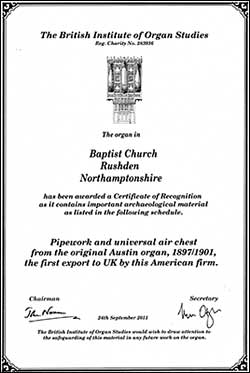Rushden’s Unique, Historic First – Born in a BARN!
We all are familiar with Rushden’s rich heritage as a centre of the leather, shoe & boot crafts. But very few are aware that Rushden has a unique, historic “first” in another craft, in the form of the Austin pipe organ now to be found in the Baptist church in Park Road. The plaque on the console declares that it was built by John T. Austin of Detroit in 1897……but in fact it was built in Knuston by John Turnell Austin, the son of a farmer [Jonathan Austin] who in 1866 built the very first Austin organ which still stands in St.Margaret’s church, Denton.
His son John was a keen musician & was taught the organ by Joseph Enos Smith, the then organist of St. Mary’s church Rushden, who remained a life-long friend. John emigrated to the USA in 1889, where in 1893 he developed an entirely novel design for pipe organs of which he built some 25 in association with the firm of Warren & Clough of Detroit. The patented design [called the Universal Windchest Organ] used as windchest an airtight room with the action of the instrument mounted on the ceiling [thus permitting easy access for installation & maintenance] with the pipes mounted externally on top. All but one of these were for American churches, the exception being the organ at Park Road Baptist church, which was the first to be exported to England in 1887. John went on in 1898 to found the Austin Organ Company of Connecticut which has since installed over 2000 organs – but only two in England, of which no trace can now be found. The Rushden instrument remains the only European example of John’s successful design.
The Rushden instrument was not first assembled in the Baptist Chapel, nor in the current Baptist church, but in father Jonathan’s barn at Knuston Lodge Farm, a fact confirmed by Joseph E. Smith’s recorded eyewitness account of this event. We surmise that John wished to show his father how to build a better organ……or more likely, to provide a sales example for the English market for church organs, which was burgeoning at the time. In January 1897, the church records of the Little Street Rushden Baptist Chapel show that an anonymous donor proposed the purchase of a new organ, offering to pay £200 [or half the cost, whichever the lesser] for a new instrument, on condition that it be installed by the end of the year.. The chapel records also show that John Austin offered the Knuston instrument to the chapel at the carefully calculated cost of £400!.
There then ensued a debate amongst the deacons of the Chapel as to whether the instrument should be immediately installed in the [Old] Chapel in Little Street, or installation delayed until the planned [New] Church was built nearby in Park Road. Enquiries were raised with John Turnell as to whether the instrument could continue to be stored until the new church was built. The chapel organ committee ultimately settled the matter by organizing the organ’s installation in the Old Chapel on the grounds that monies earned from concerts there would be useful in funding the new church building [also no doubt encouraged by the donor’s condition that installation be complete by the end of the year!]
 |
|
The new certificate
|
On completion of the new church on Park Road in 1901, the organ was moved to this new location. Records so far found reveal nothing further about the Rushden instrument until the mid-1930s, when they show that Nicholsons of Malvern had a contract for tuning & maintenance. By the late 1930s, the instrument had developed major problems &. Nicholsons recommended a complete rebuild – which because of the war & the consequent requirement for licencing of limited metal supplies – was delayed until 1945, when discussions with the church deacons were resumed. Discussions rumbled on until in 1947 Nicholsons proposed three alternative specifications for a restored instrument. The first – a basic restoration to the then current specification - was costed at £1,278. The second was an enhanced specification costed at £1,825 for restoration with the addition of a new console, blower & five new voices The third was a much more ambitious specification ultimately costed [at the insistence of the then organist] at £3,230. This proposed the addition of a further 19 voices which was claimed would give “a bolder ensemble & better accompaniment for large congregations”. This third specification would have more than doubled the size of the organ, making it a truly magnificent instrument of 33 voices capable of rendering demanding recital works. It would also have incurred spacial requirements which could not have been met within the existing organ chamber, but would have called for additional side chambers intruding into the choir pews. Not surprisingly, the church elders settled for the second specification, which was contracted in 1949 for manufacture & installation. Work began on October 3rd 1949 & was completed in time for the dedication service in December 1949 – just in time for Christmas.
The research of this history, conducted in association with the archivists of the church, the Austin Organ Company, Nicholsons & the Rushden History Society, has resulted in the award from the British Institute of Organ Studies of a certificate of recognition of the organ’s position as an English historic first & unique example of John Austin’s design.
The instrument continues to give reliable service in services & concerts: a tribute to John Austin’s ingenious design & Nicholsons’ sound craftsmanship. Designed & built by a local lad who formed an American company which has since installed over 2000 pipe organs, this is a heritage of which Rushden can be justifiably proud.
Peter Collier 2011
|